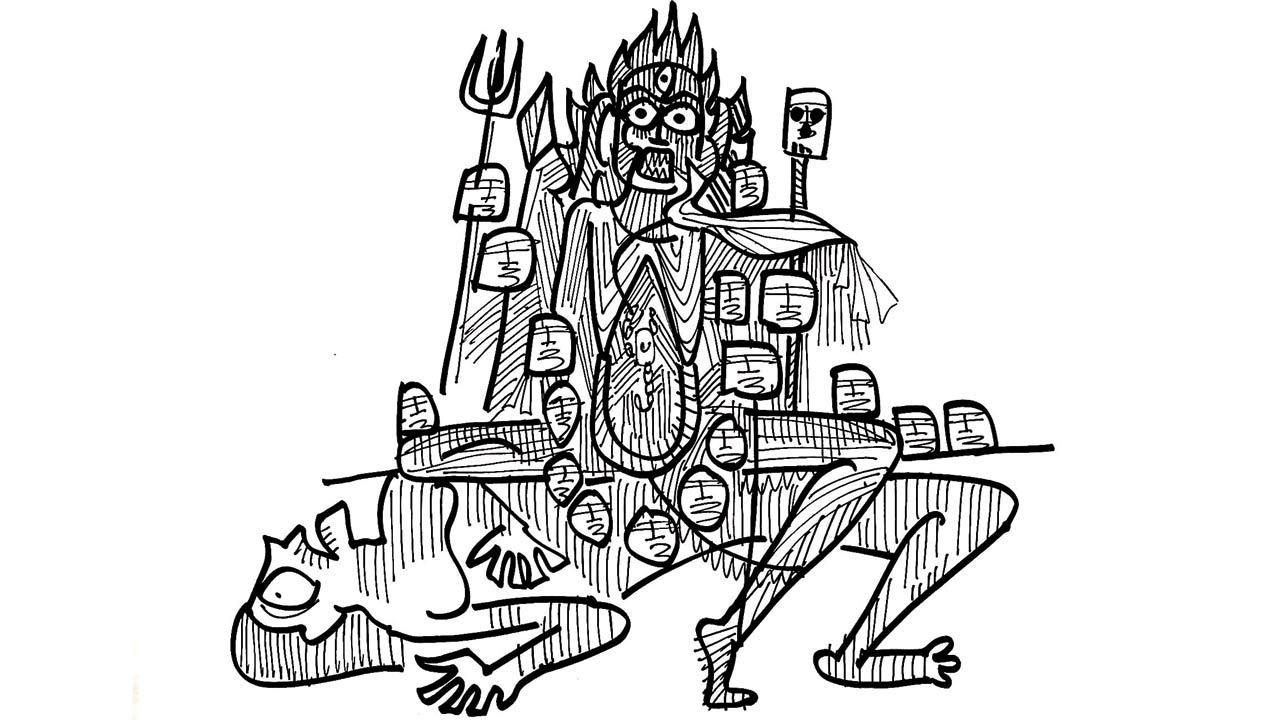Yama determines if the dead can be reborn, where can they be reborn, if they need to suffer punishments in hell before they can be reborn, based on their karmic balance sheet.

Illustration/Devdutt Pattanaik
We often read about Yama, the god of death. But technically, he is the god of ancestors (pitr) ,who resides beyond the Vaitarni, in the land of the dead, ruling over the dead. His story comes to us from the Rig Veda. He is the first mortal man who refuses to have sex with his sister Yami, the first woman, and so after death is unable to be reborn as he has no children in the land of the living. Morality comes in the way of mortality. Had he left a child behind on earth, that child could have facilitated his rebirth by producing a child of his own. But with no children on earth, he is forever trapped in the land of the dead, watching over the dead.
ADVERTISEMENT
Yama determines if the dead can be reborn, where can they be reborn, if they need to suffer punishments in hell before they can be reborn, based on their karmic balance sheet. And so, he is the cosmic accountant, fair to all, hence also called dharma. He is visualised as riding a buffalo, slowly chasing the living, catching up when it is time to die. He has a noose in hand, holding the dead hostage, ensuring everyone repays their karmic debts.
Nearly 1,000 years after the Rig Veda, the Mahabharata reached its final form. Here we find reference to a goddess linked to death. She is called Mrityu, created by Brahma who realises the living burden the earth too much, and so death is necessary. Mrityu does not want to do her duty; she finds it morbid. Brahma convinces her that she is not doing the killing. People die because of their own karma. In her watch, the body rots. In her watch, fire enables the preta (spirit) to leave the body (deha) via a hole in the head. She watches the preta confused, without body, full of memories of a life, full of desires and hungers, unable to engage with the world of the living.
The preta has to make its journey to the land of the dead and become an ancestor, pitr. If it does not, it remains trapped as a vetala and pisacha, becoming poltergeists, and possessing spaces and living bodies, driving people insane. Some pretas, especially those who died suddenly in accidents, do not want to go to the land of the dead. They cling to the past (bhoot) and haunt the land of the living as ghosts (bhoot).
This goddess of death has been identified with the Vedic goddess Nritti and with the Tamil goddess Kotravai, who lives in the desert, and in cremation grounds, and in battlefields, amongst unclaimed bodies. In art, she is visualised as Chamunda and expresses the Hindu ‘gothic’ aesthetic of disgust (vibhitsa) and terror (bhaya). She is visualised as gaunt, hungry, with a skeletal body, surrounded by ghosts, eating flesh, drinking blood, bedecking herself with entrails and bones and skulls, picking her canines, cackling at those who fear her. She is identified with Shiva’s wife, with Kali, but nothing about her form seeks to appeal to the observer. She is what we do not want to see. The horror of the crematorium, the failure of kings that frightens politicians.
The author writes and lectures on the relevance of mythology in modern times. Reach him at devdutt.pattanaik@mid-day.com
 Subscribe today by clicking the link and stay updated with the latest news!" Click here!
Subscribe today by clicking the link and stay updated with the latest news!" Click here!






